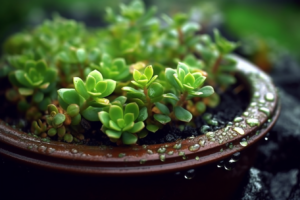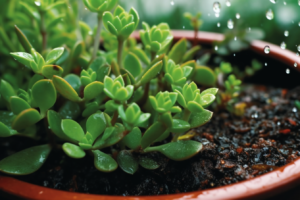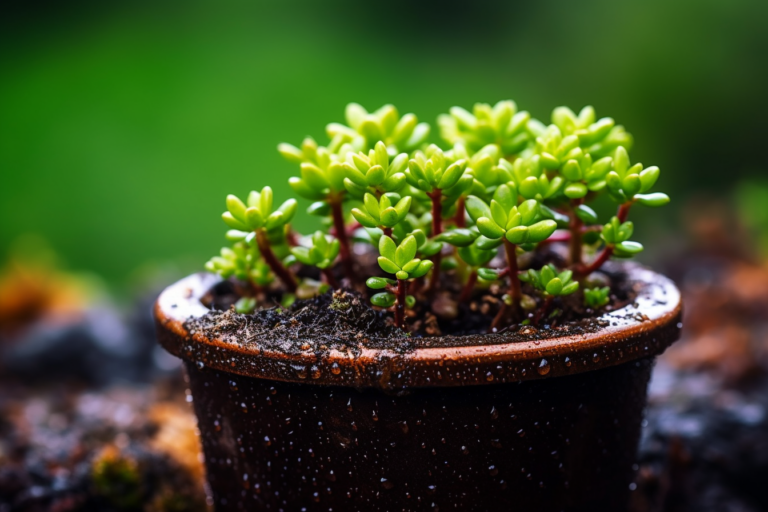Sedum plants are known for their low-maintenance requirements and ability to thrive in various conditions. However, one of the key factors in ensuring the health and growth of your sedum is proper watering. Knowing how often to water sedum can be tricky, as it varies based on several factors such as climate, soil type, and pot size.
Generally, sedum plants require watering once a week during their growing season, which is typically from early spring to fall. Overwatering can be detrimental to sedum, as it can lead to root rot and fungal diseases. It’s important to allow the soil to dry between watering, as sedum plants are able to store water in their leaves and can tolerate periods of drought.
It’s also important to note that different types of sedum may have slightly different watering needs. For example, sedum varieties that are native to arid regions may require less watering, while those that are native to areas with higher rainfall may require more frequent watering. As a general rule, it’s best to check the soil moisture level regularly and adjust your watering schedule accordingly.
The Basics of Sedum Watering Needs
When it comes to watering sedum plants, it’s important to strike the right balance. Over-watering can lead to root rot and other diseases, while under-watering can cause the plant to wilt and die. In this section, I’ll cover the basics of sedum watering needs, including how often to water and what kind of soil to use.
Frequency
Sedum plants are well-known for their tolerance to drought, making them a great choice for those who don’t want to fuss with watering plants all the time. Typically, sedum plants should be watered thoroughly, but infrequently. For outdoor plants, this usually means watering once or twice a week during the growing season. However, in very hot and dry conditions, watering may be needed more frequently.
Soil
Sedum plants prefer well-draining soil that is not too rich in organic matter. This is because they are adapted to growing in rocky, arid environments where the soil is often thin and poor. When planting sedum, it’s a good idea to amend the soil with some sand or grit to improve drainage. Avoid using heavy potting soils or composts, as these can hold onto moisture and lead to over-watering.
Container Gardening
If you’re growing sedum in a container or planter, it’s important to choose the right size container and soil mix. Sedum plants have shallow root systems and don’t need a lot of soil to thrive. Use a lightweight potting mix that is well-draining and add some perlite or sand to improve drainage. Also, make sure the container has drainage holes to prevent water from sitting in the bottom and causing root rot.
Signs of Over/Under-Watering
It’s important to pay attention to your sedum plant’s watering needs and adjust accordingly. Signs of over-watering include yellowing leaves, soft or mushy stems, and a general lack of growth. Signs of under-watering include wilting leaves, drooping stems, and a dried-out appearance.
By following these basic guidelines, you can ensure that your sedum plant stays happy and healthy. Remember, it’s always better to err on the side of under-watering than over-watering. With a little bit of attention and care, your sedum plant will thrive and bring beauty to your home or garden.
Factors to Consider When Watering Sedums
Sedums are a type of succulent that don’t require frequent watering. However, it’s important to water them properly to ensure they stay healthy and vibrant. Here are a few factors to consider when watering sedums:
Soil Type
Sedums thrive in well-draining soil that allows excess water to escape. Heavy or compacted soil can lead to root rot and other issues. When watering sedums, make sure the soil is completely dry before adding more water. Overwatering can be just as harmful as underwatering when it comes to sedums.
Season
The amount of water sedums need can vary depending on the season. During the summer months, when temperatures are hot and dry, sedums may require more frequent watering. In the winter, when they are dormant, sedums may only need water once a month or less. Pay attention to the weather and adjust your watering schedule accordingly.
Pot Size
Larger pots hold more soil and therefore more water, which can lead to overwatering if you’re not careful. When planting sedums in a pot, choose a size that is appropriate for the plant. A pot that is too large for the plant can hold too much water and increase the risk of root rot.
Climate
The climate in your area can also impact how often you should water your sedums. In dry or arid climates, you may need to water your sedums more frequently to keep them from drying out. In humid climates, you may be able to water them less often. Pay attention to the humidity levels and adjust accordingly.
Watering Technique
When watering sedums, it’s important to water deeply and thoroughly. This helps the water reach the roots where it’s needed the most. Avoid getting water on the leaves, as this can lead to rot and other issues. Instead, water the soil directly and allow it to absorb the water. Avoid overhead watering as this can cause the leaves to rot.
By considering these factors, you can ensure that your sedums stay healthy and vibrant year-round. Remember to water them sparingly and adjust your watering schedule based on the season, pot size, climate, and soil type.
Signs That Your Sedum Needs More Water
When it comes to watering sedum, finding the right balance can be tricky. While these succulent plants are relatively easy to care for, overwatering or underwatering can lead to problems like root rot or stunted growth. It’s important to pay attention to your sedum’s watering needs to ensure it stays healthy. Here are some signs that your sedum may need more water:

1. Dried Out Leaves
One of the most obvious signs that your sedum needs more water is wilted or dried out leaves. When sedum is lacking water, the leaves will start to shrivel and become crispy to the touch. While a few dried out leaves are normal, if you notice a significant number of leaves drying out, it’s a good indication that your sedum needs a drink.
2. Loss of Leaves
Another sign that your sedum is not getting enough water is the loss of leaves. When water is scarce, the plant will start to shed its leaves to conserve energy. If you notice your sedum losing leaves, it may be a sign that you need to water it more often.
3. Curling Leaves
Curling leaves can be a signal that your sedum is thirsty. When sedum is lacking water, the leaves will curl inwards in an attempt to conserve moisture. If you notice your sedum’s leaves beginning to curl, it’s time to water it.
4. Cracked Soil
If the soil around your sedum is dried out and cracked, it’s a sign that your plant is not getting enough water. The cracks in the soil make it difficult for water to penetrate down to the roots, which can cause your sedum to become dehydrated. You should aim to water your sedum before the soil has a chance to dry out and crack.
These are just some of the signs that your sedum may need more water. As a general rule, aim to water your sedum when the top inch of soil feels dry to the touch. Be sure not to overwater, as this can lead to root rot. With the right amount of water and care, your sedum will thrive and make a beautiful addition to your garden.
How Often to Water Sedum
As an avid succulent lover, I’ve found that figuring out the watering schedule for each plant can be one of the biggest challenges. In general, sedum plants are drought-tolerant and do not require frequent watering. However, the frequency of watering will depend on several factors, including the location, soil, climate, and species of sedum.
Factors to Consider
Location:
One of the most important factors in determining how often to water sedum is the location of the plant. Sedums planted in containers tend to dry out more quickly than those planted in the ground. This is due to the limited space in the container and the fact that the soil in the container dries out faster than the soil in the ground.
Soil:
Quality soil is fundamental in keeping sedums thriving. A well-draining potting mix with a gritty texture that allows for adequate air circulation is essential. Too much moisture in the soil can lead to root rot and the eventual death of the plant.
Climate:
Climate plays an important role in the water needs of sedum plants. In hot, dry climates, sedums may require more frequent watering, whereas in cooler, more humid climates, they may be able to go longer periods without water.
General Guidelines
The following are general guidelines for watering sedum:
- Water newly planted sedum thoroughly to help establish the roots.
- Wait until the soil is completely dry before watering sedum again.
- Water sedum planted in containers more frequently than those planted in the ground.
- During the winter months, reduce watering sedum to a minimum to prevent fungal disease.
- Water slowly and deeply to ensure water reaches the roots of the plant rather than just the surface of the soil.
- Avoid overwatering sedum, as this can cause the plant to rot.
In summary, sedums are drought-tolerant plants that require infrequent watering. The frequency of watering should depend on the location, soil, climate, and species of sedum. By following some general guidelines, you can keep your sedum healthy and thriving for years to come.
Tips on Watering Sedum Succulents
How often to Water Sedum
One of the most important things to keep in mind when watering sedum succulents is that they are drought-tolerant plants. As such, it is important to water them sparingly to avoid root rot and other diseases. When it comes to how often to water sedum plants, there are a few things to consider:
- Climate: Sedum plants that are grown in hot, dry climates will require more frequent watering than those that are grown in cooler, more humid climates.
- Plant Size: Larger sedum plants will require more water than smaller ones.
- Container Size: Sedum plants that are grown in smaller pots will require more frequent watering than those that are grown in larger pots.

In general, it is best to water sedum plants once every 7-10 days during the growing season. During the dormant season, which is typically in the winter months, you can reduce watering to once every 2-3 weeks.
How to Water Sedum
When it comes to watering sedum plants, you want to make sure that the soil is completely dry before you water them again. To do this, you can stick your finger about an inch into the soil and check for moisture.
When it’s time to water your sedum plant, you want to give it a good soaking. Water the plant until the water runs out of the bottom of the pot. This ensures that the entire root system gets watered.
It’s important to avoid getting water on the leaves of the sedum plant, as this can lead to rot. Instead, water the soil directly and let the plant soak up the moisture through its roots.
Tips for Watering Sedum Succulents
Here are a few additional tips to keep in mind when watering sedum succulents:
- Use well-draining soil: Sedum plants require soil that drains well to avoid root rot. Be sure to choose a soil mix that is specifically formulated for succulents.
- Water in the morning: It’s best to water sedum plants in the morning, as this allows any excess water to evaporate before the cooler evening temperatures set in.
- Avoid overwatering: Overwatering is one of the most common mistakes that people make when caring for sedum succulents. Be sure to give the soil time to dry out completely between waterings.
By following these tips, you can ensure that your sedum succulents stay healthy and happy for years to come.
FAQS
What kind of soil is best for sedums?
Sedums prefer well-draining soil that doesn't hold water for too long. A mixture of sand, perlite, and peat moss is an excellent choice for sedums.
Can sedums survive in full sun?
Sedums are sun-loving plants and can thrive in full sun. However, they can also grow in partial shade.
How do I know when my sedum needs water?
Check the soil's moisture level by inserting a finger into the soil up to the second knuckle. If the soil feels dry, it's time to water the plant.
Can I water my sedum with tap water?
Yes, you can water your sedum with tap water. However, if your tap water has high levels of chlorine or fluoride, it's best to use distilled or filtered water.
Can I fertilize my sedum plants?
Yes, you can fertilize your sedum plants during the growing season with a balanced fertilizer. However, sedums do not require frequent fertilization.


I water my sedum once a week during the growing season and reduce it to once every two weeks during the winter. It’s important to let the soil dry out between waterings to prevent root rot.